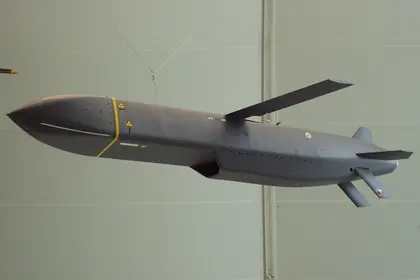France’s announcement on Tuesday that it would send SCALP long-range missiles to Ukraine comes months after Britain began delivering its identical Storm Shadow.
Developed jointly by the two NATO allies, Storm Shadow/SCALP is a 1,300-kilogramme (2,870 pounds) missile armed with conventional explosives, usually launched from aircraft such as the Royal Air Force’s Eurofighter Typhoon or French Rafale.
JOIN US ON TELEGRAM
Follow our coverage of the war on the @Kyivpost_official.
The first SCALPs were already in Ukraine as President Emmanuel Macron announced their delivery, a French military source told AFP Tuesday on the sidelines of the NATO summit in Lithuanian capital Vilnius.
Built by missile maker MBDA, the missile’s range of over 250 kilometres (155 miles) makes it the longest-range Western weapon supplied to Kyiv so far.
It is capable of striking targets far into the country’s Russian-occupied east, well behind front lines that have remained relatively fixed for months.
Such capability is “critical for Ukraine’s forces to disrupt Russian logistics and command and control,” said Ivan Klyszcz, a researcher at the Estonia based International Centre for Defence and Security (ICDS).
SCALP strikes could help “with Ukraine’s current approach to operations... namely to advance slowly so as to protect its forces and reduce its own casualties as much as possible,” he added.
French deliveries would “preserve the clarity and coherence of our doctrine, which is to allow Ukraine to defend its territory” from Russian invasion, Macron said.

Zelensky Meets CIA Director William Burns in Ukraine
The subtext is that French-supplied weapons should not be allowed to hit Russian territory, after Moscow’s repeated warnings of reprisals.
Macron’s message matched that of Britain’s Defence Secretary Ben Wallace, who said in May that Storm Shadow would “allow Ukraine to push back Russian forces based within Ukrainian sovereign territory”.
- ‘High-value targets’ -
“With these weapons, a few jets operating within the safe space of their own air defences can make a difference,” said Dylan Lehrke of UK-based private intelligence firm Janes.
“Russian forces can deny Ukrainian aircraft the use of airspace above territory they control, but they have been unable to defend against deep strikes,” he added.
Manufacturer MBDA says on its website that the SCALP is “designed to meet the demanding requirements of pre-planned attacks against high-value fixed or stationary targets such as hardened bunkers and key infrastructure”.
It has been used in previous conflicts including in Iraq, Libya and Syria.
The missile uses inertial navigation, GPS and terrain referencing to chart a low-altitude course to its target to avoid detection.
It uses an infrared camera to match images of the target to a stored picture “to ensure a precision strike and minimal collateral damage,” MBDA says.
The warhead can be programmed to detonate above the target (airburst), on impact or following penetration.
Russian-installed officials said last month that a British-supplied Storm Shadow had hit a bridge at Chongar, which links the annexed Crimean peninsula to southern Ukraine.
The bridge was “unusable” following the strike and would be closed for around 20 days, Moscow’s governor for southern Ukrainian region Kherson, Vladimir Saldo, said at the time.
Russia claimed soon after Britain began delivering the missiles in May that it had already shot down a Storm Shadow.
But both sides in the conflict regularly claim to have destroyed the other’s hyped high-tech weapons.
In recent months, Ukraine has claimed kills of Russia’s Kinzhal hypersonic missiles and Moscow has highlighted successes against German-made Leopard tanks operated by Kyiv.
As with many Western arms supplied to Ukraine, France’s stocks of the SCALP are not bottomless.
Trade magazine Defense et Securite Internationale has reported that Paris has “fewer than 400" of the missiles.
You can also highlight the text and press Ctrl + Enter






